By Nathan Prefer
At age 86, with a full and successful career behind him, General of the Army Omar Nelson Bradley sat down to write his uncensored memoirs. Although he had written a memoir of his World War II service earlier (A Soldier’s Story), he felt the need to be fully candid and open about his experiences.
One of the things he was to describe was his regret at the amount of time, effort, and blood that he had expended in the prolonged seizure of France’s Brittany Peninsula. He recalled that the “frustrating Brittany campaign” might have been better if the Allies had not fought it at all.
As he wrote, “We might have been well advised at this point to give up the good fight and let Brest remain in German hands, contained by our newly arriving green infantry divisions or by the French Forces of the Interior, which had ably assisted Patton’s run through Brittany.”
Thirty-five years earlier, the situation seemed different to those on the ground in France. The Allies had determined that seizing a defended port by direct amphibious assault was impractical—a lesson driven home by the 1942 Canadian raid at Dieppe. Instead, at Normandy the Allies would assault over open beaches, bringing a pair of temporary ports (“Mulberry” harbors) with them. The intent was to seize French ports quickly to allow logistics to keep up with the projected Allied advance to Germany.
As is usual in war, plans failed to match events. The Allies became stalled in Normandy, one of the temporary ports was destroyed by a storm, and the beaches, while difficult, sufficed for the first two months of the invasion, along with the port of Cherbourg, which was captured early but was badly damaged by the Germans. Things soon changed again when the Allies launched Operation Cobra, the breakout from Normandy and into the French interior.
It was this breakout that launched the Brittany campaign. The original Allied plans called for securing the entire Brittany Peninsula as a part of the initial lodgment area. Although much delay had ensued, the original plans were still in effect and, as the First U.S. Army broke out of the Normandy beachhead, Lt. Gen. George S. Patton’s newly arrived Third U.S. Army raced past its flank and moved east and south. The southern thrust was the VIII U.S. Corps under the command of Maj. Gen. Troy H. Middleton.
This thrust into Brittany would give the Allies a total of 500 miles of French coastline, including some good ports at Rouen, Le Havre, Cherbourg, St. Malo, Brest, Lorient, and Vannes. Several smaller harbors would also come under Allied control. All of these would be under the protection of Allied air power based in Britain, while at the same time providing additional, closer air bases for the advancing armies.
The turn into Brittany was led by the U.S. 4th and 6th Armored Divisions, followed closely by the 8th Infantry Division. The initial advance, once a breakthrough had been achieved, was surprisingly swift. The two armored divisions rounded up some 4,000 German prisoners while the infantry division added 3,000 more to the POW enclosures. American losses numbered fewer than 700 from all causes.
German disorganization was obvious and rampant. Destroyed and abandoned enemy equipment, including guns, tanks, and trucks, littered the roads and countryside and formed the chief obstacle to the American advance. Clearly disorganized German units were fleeing into the Brittany Peninsula. Even the Germans described it as a “Riesensauerei”—one hell of a mess.
The initial Allied attack on July 25 had started slowly due to strong German resistance, but as the German reserves, already inadequate, were used to delay one of the Allied thrusts, another quickly pushed forward. By August 1, 1944, the front had broken wide open. The German LXXXIV Corps was smashed, and the II Parachute Corps was defeated, as was the parent Seventh German Army. American troops stood at the entrance to the Brittany Peninsula.
Hitler’s reaction to Cobra was to delay as much as possible the Allied advance to gain time to rebuild his defenses deeper inside France. To this end he ordered his troops to destroy all transportation facilities, locomotives, railway lines, and bridges. His second step was to order his “Fortress Policy” into effect.
This latter plan was designed to deny the Allies the essential port facilities they needed logistically while at the same time keeping his hold on advance submarine bases from which his naval forces could strike at the Allied supply lines across the English Channel and Atlantic Ocean.
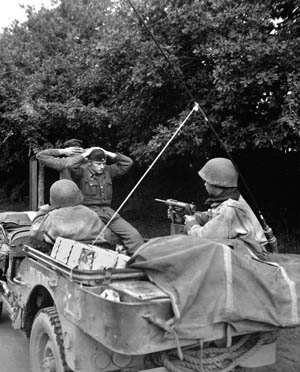
In preparation for this, from 1943 onward the ports of France, Holland, and Belgium had been heavily fortified by the Germans for just such an eventuality. Each was assigned a commander who had personally vowed to fight to the death to defend his fortress. So far, only Cherbourg had fallen to the Allies, and only after a bitter fight that destroyed a good deal of the port.
Now the Allies had seized the small ports of Avranches and Pontaubault on the Contentin Peninsula and were about to threaten major ports in Brittany, including St. Malo, Brest, Lorient, and St. Nazaire.
Disappointed in what he considered the too rapid fall of Cherbourg, Hitler renewed his directive and ordered each port held “to the last man, to the last cartridge.” This order, unpopular with the German Army, nevertheless was put into immediate effect, tying up about 750,000 German troops.
Hitler, satisfied that his Fortress Order would prevent the Allies from gaining the vital Brittany ports, ordered his field commander, Field Marshal Gunther von Kluge, to ignore the Brittany front and concentrate his forces on slowing the Allied drive to the Seine River.
To obey these orders, Kluge requested permission to move the 2nd German Parachute Division from Brest to the east and the 319th German Infantry Division, then occupying the Channel Islands as well. Hitler refused to evacuate the Channel Islands, but did give permission for the paratroopers to leave Brest.
But it was too late. Even as the first German paratroopers began to move, they encountered the advance elements of American armor approaching the port city. They had no choice but to withdraw into the defenses of Brest. As they did so, more and more reports of American armor advancing into Brittany reached them.
These same reports reached von Kluge, and he abandoned the idea of moving the paratroopers. Looking for some force to at least attempt a defense of Brittany—if for no other reason than to tie down Allied forces—he turned to General Wilhelm Fahrmbacher, commanding XXV Corps.
Fahrmbacher had fought the Americans before in the Contentin Peninsula and did not relish another round. Although at one time Brittany held some 100,000 German troops, most had been sent to fight in Normandy. Left to Fahrmbacher in August were the 2nd German Parachute and the 343rd Infantry Divisions. Elements of the 266th and 265th Infantry Divisions, the latter holding the ports of Lorient, St. Nazaire, and Nantes, were also available. The usual collection of coast artillery, antiaircraft, antitank, engineer, navy, and air force units were also included under Fahrmbacher’s XXV Corps. Additionally, he picked up straggler units from the 77th and 91st Infantry Divisions that had escaped from Normandy into Brittany.
Hitler’s Fortress Order dictated that these field forces would remain under the command of their leaders as long as they operated outside the delineated confines of the particular fortress. Once they were pushed into the fortress, all forces, including the field forces, came under the command of the fortress commander. In most cases, the defenses of these fortress ports faced the sea, the expected focus of attack.
Fahrmbacher and his headquarters moved to Lorient. On August 7, von Kluge ordered him to move to and take command of Brest, but already the lines of communication were cut and XXV Corps remained in Lorient. With land and sea routes cut and communications difficult if not impossible, each fortress essentially fought alone. In effect, Fahrmbacher would become fortress commander of Lorient.
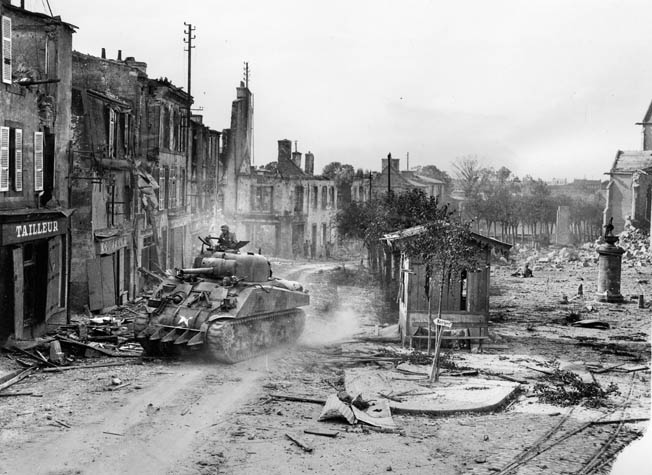
American planners had always intended for the XIII U.S. Corps and one or two others to turn into Brittany and clear the ports. German disorganization offered the Americans the chance to use only VIII Corps for this role. Middleton’s corps had fought in Normandy as a part of the First U.S. Army under Bradley, but on August 1, 1944, with the activation of the Third Army, it became a part of Patton’s army.
Patton was under orders to secure the Brittany Peninsula, particularly the ports of St. Malo, the Quiberon Bay area, and Brest. Army engineers were alerted to prepare to open these ports as soon as they were secured by VIII Corps.
Patton was to cut across the base of the peninsula, thereby isolating it from the rest of the German Army. Next, he planned to clear central Brittany, open lines of communication, and reduce German defenses to the isolated pockets of resistance around the ports. The plan assumed that once the German port defenders were isolated they would surrender after a token resistance.
To accomplish this, Patton ordered Maj. Gen. John S. Wood’s 4th Armored Division to strike through Rennes to Quiberon; Maj. Gen. Robert W. Grow’s 6th Armored Division would then head directly for Brest. A third column, a temporary task force (“Task Force A,” under Brig. Gen. Herbert Earnest), was directed to secure the vital railroad line that leads from Brest along the north shore. This railway crossed several bridges, each of which had to be secured for the rail line to remain functioning.
Task Force A, consisting of the 15th Cavalry Group and 6th Tank Destroyer Group, would be under the supervision of General Grow. Overall, Patton intended a quick, slashing attack that would increase German disorganization and disrupt their defenses to the point that the objectives could be secured with relative ease.
Patton sent forward his personal reconnaissance force, Colonel Edward M. Fickett’s 6th Cavalry Group—which he renamed the Army Information Service—and made it a communications unit directly responsible to his headquarters, allowing him to receive current, updated, and accurate information on his wide-ranging forward units.
Major General Troy H. Middleton, the VIII Corps commander, formerly commanded the 45th Infantry Division in Sicily and Italy; he did not have much experience with armored warfare, preferring the planned and carefully coordinated thrust of an infantryman.
Middleton was still following the original Allied plans for the invasion and exploitation phases of the campaign. He intended to send two columns into Brittany, like Patton, but each would include both an armored and an infantry division. The 4th Armored Division would be followed by Maj. Gen. Donald Stroh’s 8th Infantry Division; Maj. Gen. Ira T. Wyche’s 6th Armored Division would be followed by the 79th Infantry Division. Further, Middleton believed that his primary task was to secure St. Malo, then Quiberon.

Both Grow and Earnest were members of the armor “club” and, like Patton, favored thrusts deep into the heart of the enemy’s defenses rather than a deliberate attack against prepared defenses. As a result, they did not intend to tie down their forces fighting prepared defenses, for which their armor was not intended.
The past few weeks of rapid advance against weak defenses had made Grow and Earnest confident that a quick overrunning of the Brittany Peninsula would result in the conquest of the territory as well as the ports.
In effect, each division commander became semi-independent. Middleton’s headquarters was located near Avranches, but the rapid advance of his troops left his communications in confusion. Messages were received late, when received at all. Similarly, orders sent forward either never arrived or were obsolete when received. As a result, a great deal of confusion arose during the Brittany campaign.
Although Middleton attempted to move his headquarters forward to regain communications with his assigned units, Third Army ordered him to remain in touch with them, thus preventing a move. At one point Middleton reported that contact with his forward armored divisions was “practically nil.”
The communications failures were not limited to the higher headquarters. In the 6th Armored Division, for example, General Grow became dissatisfied with the progress of Combat Command A and ordered Combat Command R to change direction and follow Combat Command B. These orders were likewise delayed in transmission because neither command knew the other’s location. Eventually things were sorted out and the adjustments made, but precious time was lost.
Throughout Brittany in early August, the scenes played out much like the American Wild West of a century before. Messengers going from one headquarters to another had to run a gantlet of ambushes, destroyed bridges, and snipers to deliver their messages.
In one case, it took an officer messenger from VIII Corps to 6th Armored Division 24 hours to make the round trip, during which he was able to avoid death or capture from roving bands of German soldiers only due to timely warnings from the civilians along his route.
Supply trucks, particularly single trucks traveling alone, reminded some of the old stagecoach racing through “Indian Country,” moving fast to avoid the sudden ambushes of wandering German units. Even German aircraft, flying to dispute the rapid American advance into the peninsula, often strafed individuals or single vehicles.
Wood’s 4th Armored Division aimed for Rennes, the capital of Brittany and the center of a vital road network. Working under two sets of orders—one from Patton ordering the division to capture Rennes and then move on Quiberon and the other from Middleton ordering only the capture of Rennes—Wood’s men raced 40 miles southwest to reach the outskirts of Rennes by the evening of August 1.
Strong German opposition protected the city of some 80,000 residents, and an initial attack by 20 Sherman tanks and a company of infantry failed to penetrate those defenses. A conglomeration of German infantry, antiaircraft troops, machine gunners, and naval troops defended the city. Fahrmbacher had sent a small force drawn from the 91st Infantry Division to hold the town, as it was a vital communications center for both sides due to the road network. Before the Americans could reorganize, another two battalions of replacement troops arrived from Le Mans.
The 4th Armored Division launched a renewed attack late on August 1. Despite a preliminary bombardment from Republic P-47 Thunderbolt fighter-bombers and artillery, the attack was again thrown back; 11 American tanks were lost. That same evening Colonel Eugen Koenig, commander of the 91st Infantry Division, arrived in the city with two assault guns. He immediately took command and prepared an all-out defense.
Wood realized that there would be no swift overrunning of Rennes. Even as his troops waited outside the city, they were being mortared and shelled by artillery from within. So intense did this fire become that the Americans prepared for a counterattack.
Wood was in a difficult position with his supplies running short, his division strung out over some 50 miles between Avranches and Rennes, and insufficient infantry to clear a large city. He radioed Middleton for an infantry regiment to reinforce him. He also requested air cover, something he had not received except for the P-47 strike that had apparently accomplished little.
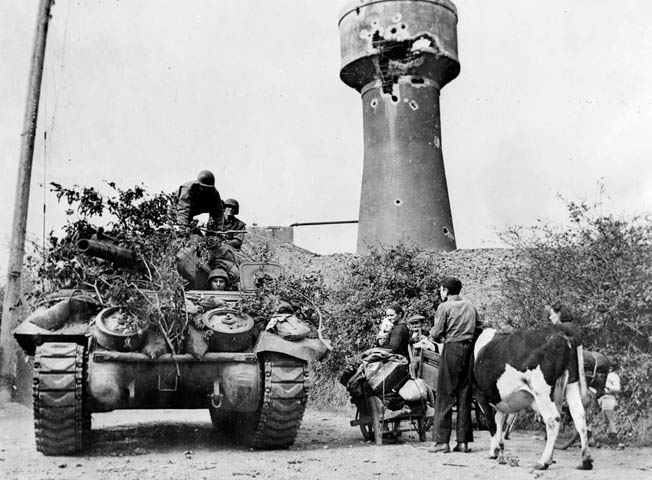
The nearest infantry was Stroh’s 8th Infantry Division, which had been fighting in Normandy since the beginning of July. Ordered to follow the armor and be prepared to supply troops to allow the armor to bypass enemy strongpoints, Stroh attached his 13th Infantry Regiment to the 4th Armored Division. Quartermaster truck companies ordered up by Middleton from the Third Army carried the infantrymen toward Rennes.
To keep the Germans busy while he waited, Wood sent a series of small infantry attacks against the city during the day. To Wood, the war was moving to the east and north, away from Brittany. With Stroh’s division coming to relieve him at Rennes, he wanted to bypass it and keep up with the American advances to the east.
Wood’s maneuver would encircle Rennes while at the same time putting him in a position to seal off the Brittany Peninsula, a major objective of his drive. He sent his plan to Middleton and, in anticipation of approval, he began to move. But Wood’s plan crossed an incoming order from VIII Corps that restated his orders to capture Rennes. Upon receipt of this order, Wood felt he had no alternative but to halt his movement around Rennes and renew his attack on that city.
Wood already had two combat commands moving around Rennes, and these found almost no enemy opposition. By the end of the day, the peninsula was sealed off from the rest of France. Upon receiving this report, Middleton accepted the situation and forwarded the report to Third Army. But he once again reminded Wood that his objective was to secure Rennes.
Middleton’s order to capture Rennes was not as poorly considered as it was later made out to be. Wood’s division was still widely dispersed and his supply routes were under attack by the “Indians”—German troops still roaming the unsecured sections of the American rear. He needed to secure the supply route to keep his division supplied sufficiently for continued advances.
To accomplish this, Wood halted his columns and turned them northward to block German escape routes to the east. He ordered the approaching 13th Infantry Regiment to capture the city itself. By August 4, the 4th Armored had cut the main routes southeast of Rennes and pushed the roaming German units away.
The 13th Infantry Regiment reached the vicinity of Rennes late on August 2 and prepared to assault the city the following morning. Despite strong enemy small arms, automatic weapon, and antiaircraft fire turned against ground troops, the infantry penetrated the city’s defenses in the northeastern sector on August 3.
The Germans were now surrounded. Colonel Koenig could see the handwriting on the wall and requested permission to withdraw his forces from the city. After receiving permission from the Seventh Army Headquarters, the defenders burned their supplies, and the surviving Germans, estimated at about 2,000, left the city in two groups during the night of August 3-4.
Using back roads and cross-country trails, they reached St. Nazaire after a difficult five-day journey and joined the garrison there. On August 4, the 13th Regiment, followed by the rest of the 8th Infantry Division, made a triumphant entry into Rennes to the cheers, flowers, and wine of the liberated French population. It garrisoned the town and became the XIII Corps reserve.
Once again communication failures plagued General Wood. Repeated messages to Middleton seemed unanswered, although in fact the responses never arrived. Frustrated, Middleton drove through Brittany and arrived at Wood’s headquarters to discuss future operations.
Upon arrival, Wood hugged Middleton in ecstatic welcome. Middleton asked what the matter was, fearing that Wood’s division had suffered some major reverse. “No,” replied Wood, “They”—meaning the Allied command—“are winning the war the wrong way.” Wood still wanted to move east.
A compromise was reached whereby Wood would move east but concentrate on blocking all routes south of Rennes and seizing the Vilaine River bridges. A copy of this compromise was forwarded to Third Army headquarters where Maj. Gen. Hugh J. Gaffey, Patton’s chief of staff, issued an order reminding both field commanders that their objective remained the Quiberon area and the towns of Vannes and Lorient.
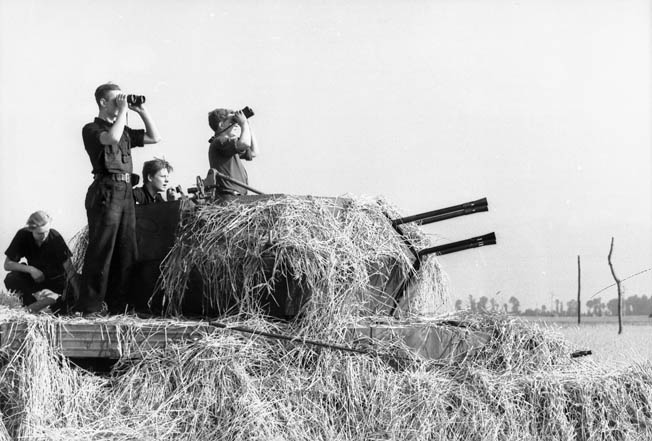
As Middleton passed on this adjustment, the 4th Armored Division ran out of gas. Although the shortage was temporary, due to the supply trucks having been diverted to carry forward the 13th Regiment earlier, it caused little change. French Forces of the Interior (FFI) had captured the airfield at Vannes, and elements of Wood’s division arrived the following day, completing the town’s capture.
To keep the pressure on the enemy, Colonel Bruce C. Clarke, commanding 4th Armored’s Combat Command A, sent a task force to the outskirts of Lorient, ensuring that the Germans remained within the fortress. Combat Command B, under Brig. Gen. Holmes E. Dager, soon joined them in establishing a siege of Lorient.
Initial attempts to find a weak spot in the defenses by Combat Command B cost them 20 men killed and 85 wounded, as well as a dozen or more vehicles destroyed. Although Fahrmbacher was concerned that a strong American attack would breach his defenses, but no such attack was launched. His defenses were still being organized, and some sectors of the defense were as yet unoccupied. He had some 25,000 German troops, 10,000 French civilians, 197 artillery tubes, and 80 antitank guns in the fortress.
Middleton had no intention of launching a major attack. An armored division was ill suited for such an assault, and no infantry division was immediately available. In fact, Lorient would never be attacked by the Americans and would continue to send out its German submarines to harass Allied shipping until Germany’s surrender in May 1945.
One of the reasons no infantry division was available to assist Wood at Lorient was that the war had already bypassed Brittany. The main action of the Allies’ Northwest Europe campaign was to the north and east; no new forces would be available for Brittany. Middleton was soon advised that he would have to clear the peninsula with the forces at hand.
His priority now became the seizure of St. Malo and Brest; only after St. Malo and Brest were captured could he spare forces to assist Wood at Lorient. With his now limited forces, Middleton had to prioritize his objectives because the same forces would be used at each.
The 6th Armored Division had already begun the process. General Grow had already sent Combat Command Reserve (CCR, Colonel Harry F. Hanson) to the Pontaubault bridgehead in anticipation of an advance deeper into Brittany. Grow intended to pass his other two combat commands through CCR once Middleton gave his approval.
That approval came even before CCR arrived at Pontaubault. With his other commands delayed by destroyed bridges and roads, Grow changed his plan and ordered Hanson to continue past Pontaubault and push into Brittany. The rest of the 6th Armored would follow as soon as possible.
To make matters more urgent, Patton arrived just as Grow was personally directing traffic to get his troops on the road. Telling Grow that he had a bet with British Field Marshal Bernard L. Montgomery that he, Patton, would have troops in Brest by Saturday night, he told Grow, “Take Brest.”
When asked by Grow about intermediate objectives, Patton told him to preserve the Brest-Rennes railroad but otherwise to bypass all resistance. Grow needed nothing further and dismissed his current objective of Dinant and ordered his men to Brest, some 200 miles west of Avranches. He had five days to win Patton’s bet.
Patton’s order was not the flippant remark of a careless commander. Armor officers were trained to push the envelope by giving subordinates far-reaching objectives to keep them thinking ahead and prepared for sudden alterations in existing plans. Grow, who had worked for Patton as an operations officer years earlier, was familiar with such tactics.
Middleton suggested two routes for 6th Armored to get to Brest. He also reinforced the division with the 174th Field Artillery Battalion’s 155mm self-propelled guns, the 603rd Tank Destroyer Battalion, and the 777th Antiaircraft Artillery (Automatic Weapons) Battalion.
Getting his division through the crowded and devastated city of Avranches, though, was Grow’s first problem. As mentioned, congestion was so bad that he personally had to direct traffic to extricate his division from that city. German air attacks on both August 1 and 2 slowed things down as well. Destroyed bridges forced the entire division to cross slowly over the sole highway bridge into Brittany.
To speed up his advance, Grow split his division into two columns, hoping that if one was halted by enemy resistance the second could outflank that resistance and continue the race to Brest. Hanson’s CCR led one column and Brig. Gen. James Taylor’s CCA the other. Colonel George W. Read, Jr., led CCB, which followed CCR.
The “Super Sixth” expected to find German troops in front of them. The general disposition of the enemy was known, and they expected to encounter the German paratroops around St. Malo.
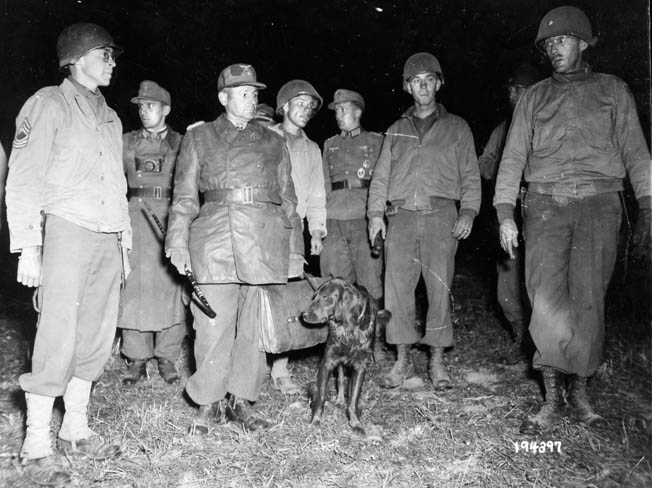
Sure enough, the advance guard was soon ambushed by strong enemy forces, forcing Hanson to attack to his rear to clear the enemy from his column. Grow overruled him, ordering him to continue forward while the following units of CCB dealt with the Germans.
After three hours, 70 casualties, and the loss of some vehicles, Hanson’s CCR broke the German ambush and continued toward Brest.
Moving forward with nothing more than a general map of Brittany, Grow pushed on. Combat Command B took the lead from CCR and ran into resistance near Dinan, which Grow ordered bypassed. With the help of some air support, this was soon accomplished.
Worried about his lines of communication and supply, Grow halted his division for the night of August 2-3. He knew that his assigned support, the 79th Infantry Division, had been diverted to the east. He had heard that they might be replaced by the 83rd Infantry Division, but Grow had no idea if and when that might occur. Even if they were, it was several days behind the “Super Sixth.”
Grow had little intelligence on the enemy. Although his staff advised caution, stopping to develop support bases rather than a wild race down unknown roads against an unknown enemy, Grow dismissed their advice; he didn’t have that kind of time. When he revealed that the division’s objective was now Brest, not Dinan, the staff was astonished.
At his staff conference, so exhausted were the officers and men of the division that several fell asleep during the discussion. Grow ordered his division to rest and reorganize until noon on August 3. Then, once again, it was off.
Colonel Taylor’s CCA hit some resistance when they took a wrong turn near Mauron but quickly overcame it. Colonel Read’s CCB raced 30 miles without a shot fired against it, although the men could see retreating Germans in the distance. Then suddenly came the order to halt.
That order came from Middleton, who wanted Grow to reinforce and take command of the forces attacking St. Malo. A portion of the 83rd Infantry Division and General Earnest’s Task Force A were besieging the town, and Middleton wanted Grow to assist.
General Grow protested the order, first by radio and then again by courier. While awaiting a response, he obeyed his orders, halting CCA and ordering CCB to turn around. Then he changed his mind and left CCB where it was, hoping for a change in orders. Using troops from CCR, he organized a special task force, placed Colonel Taylor in charge of it, and ordered the force to its new objective. Just then the courier returned with the answer to Grow’s request to continue to Brest: “No.”
As the division was planning its attack on Dinan, Patton once again showed up. He immediately berated Grow for halting, but the division commander explained his new orders, which Patton quickly overruled. Once again the 6th Armored Division was headed for Brest.
Later it would turn out that once again confused and incomplete communications had resulted in this mixup. When Middleton issued his order, he believed that the 6th Armored Division was at or near Dinan when, in fact, it had already bypassed that location and was well south of it when the order reached Grow.
It wasn’t until the pilot of a light artillery observation plane reported, accurately, the location of the 6th Armored Division that Middleton realized his error and changed his orders. Even this change was delayed, repeated, and lost in transmission for a while. Patton’s own “Army Information Service” (6th Cavalry Group) also tried to forward the order, but it took most of a day to clear up the change in orders.
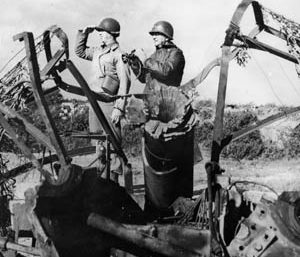
When 6th Armored began moving again, communications failed altogether. For much of August 4, no higher headquarters could communicate with the “Super Sixth.” Fragmentary messages indicated that the division was approaching Brest, needed air support and bridging equipment, and was working with the FFI. Complaints about enemy troops harassing their lines of supply were also received.
Patton could stand it no longer. He ordered fighter-bombers over Brest to report on the situation. He wanted to know where the division was and what it was doing. He needed to know, also, whether the division needed assistance in seizing Brest. He also assigned his Army Information Service to do the same.
A reply soon came from the 6th Cavalry Group, reporting first the seizure of Brest and then correcting it to state that the attack would begin tomorrow, August 7. Still believing that the condition of the German Army in Brittany would result only in a token defense of Brest, Patton continued to try to contact Grow, all to no avail.
In fact, 6th Armored was on the move, even driving through one moonlit night to make up time lost at Dinan. With support from the FFI, which guided him past German defenses and around destroyed bridges, Grow pushed his troops forward. When the 15th Tank Battalion ran into a minefield, 2nd Lt. James I. Durden went forward alone and cleared a path through it at great personal risk. He then repeatedly walked through the field, guiding drivers along the cleared path until he was killed.
But clashes like these did little to slow the advancing armor, and men like Lieutenant Durden pushed aside the German efforts at delay, despite the cost to themselves. By the evening of August 6, the division was threatening the outposts of Fortress Brest.
The Army Air Forces found the division that same day, and General Grow responded to their requests for information that he thought Brest would be defended and that he needed an infantry division to do the job.
While awaiting orders, Grow decided to try out Brest’s defensive strength. He believed his rapid advance had demoralized the Germans and disrupted their preparations for defense. He ordered Colonel Read and CCB to attack on the morning of August 7. The attack overran some strong outposts but hit the wall of German defenses some seven miles outside the city. By the end of the day, 6th Armored besieged Brest at a distance of from four to six miles. Still hoping that the enemy planned only a token defense, Grow sent a surrender ultimatum into the fortress.
Behind the 6th Armored Division a bitter battle had developed at St. Malo. Maj. Gen. Robert C. Macon’s 83rd Infantry Division had replaced the 79th Infantry Division in that assignment when the latter was diverted to block German communications at Fougéres.
Although a small port on the northern coast, St. Malo held an important strategic position in that enemy forces based there could cut off American communications to the interior of Brittany.
The fortress commander at St. Malo was Colonel Andreas von Auluck who, to strengthen his defenses, asked the French population to leave. They in turn asked the Germans to leave. Auluck asked for a decision from Hitler, who responded, “In warfare there is no such thing as an historic city.” The ancient walled town dating from the 15th century would become a battlefield.
After relieving Earnest’s Task Force A, Macon began his attack. A battalion of infantry sent across the Rance River in assault boats was repelled by strong resistance. But the attack convinced the Germans to abandon Dinan and withdraw into the final fortress defenses.
With three regiments in line, the 83rd launched its attack, but not before Auluck ordered all French civilians out of St. Malo under cover of a white flag. Once the civilians were clear, German artillery offshore on the Ile de Cézembre opened fire. This shelling started severe fires within the city. With water supplies cut off by the Americans, the Germans couldn’t adequately fight the fires.
On August 7, the Germans destroyed the harbor facilities. But defenses remained strong, and Macon was allocated the 121st Infantry Regiment of the 8th Division. This Georgia National Guard regiment would attack via the Rance River while the 83rd Division attacked St. Malo directly. At one point Lt. Col. Gordon Eyler’s 3rd Battalion, 121st Infantry Regiment found itself surrounded near Pleurtuit. German artillery, mortar, and small arms fire pounded the trapped Americans. Breakout attempts as well as relief attempts failed. The “Lost Battalion of Dinard” fought on.
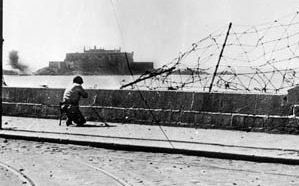
General Macon took personal charge of the rescue once he was satisfied that the battle for St. Malo was progressing well. He moved his 331st Infantry Regiment to the area of the trapped battalion and led an attack to relieve it, which took a week to accomplish.
Meanwhile, at St. Malo the battle raged street by street and house by house. It was bitter, bloody fighting with little quarter given. On August 14, the same date the “Lost Battalion of Dinard” was relieved, the final German stronghold was reached. This 18th-century fortress withstood the initial American attacks. Heavy guns were brought up to point-blank range and fired at the citadel, bombers blasted it from the air, and small assault teams attacked position after position. Colonel Auluck, having been awarded the Oak Leaves to the Knight’s Cross, surrendered August 15.
At Brest things were equally difficult. General Grow soon became aware of a large enemy force attacking his rear. This force, from the 266th Division, was identified when the commander (Maj. Gen. Karl Spang) was captured by the 212th Armored Field Artillery Battalion. The “Super Sixth” had to turn around and fight off these attackers while leaving a token force facing Brest.
With his command post under attack, Grow signaled VIII Corps that he was defending his headquarters and prepared to destroy secret codes if overrun. Naturally this message caused consternation at VIII Corps headquarters. But after two days, half of the German force was killed or captured; the rest escaped into Fortress Brest.
General Middleton relieved the armor with what would soon total three infantry divisions. Maj. Gen. Walter M. Robertson’s 2nd Infantry Division held the left flank, the 8th Infantry Division the center, and Maj. Gen. Charles H. Gerhardt’s 29th Infantry Division the right.
Inside Fortress Brest, commanded by Colonel Hans von der Mosel until relieved by Maj. Gen. Bernard Herman Ramcke, commander of the 2nd Parachute Division, there were by August 10 some 35,000 German Army, Navy, and Air Force troops manning the defenses. Ramcke, a World War I veteran and devoted Nazi, would not yield easily. With sufficient troops, proven defenses, fortifications, and adequate food and ammunition, the siege of Fortress Brest promised to be a bloody one.
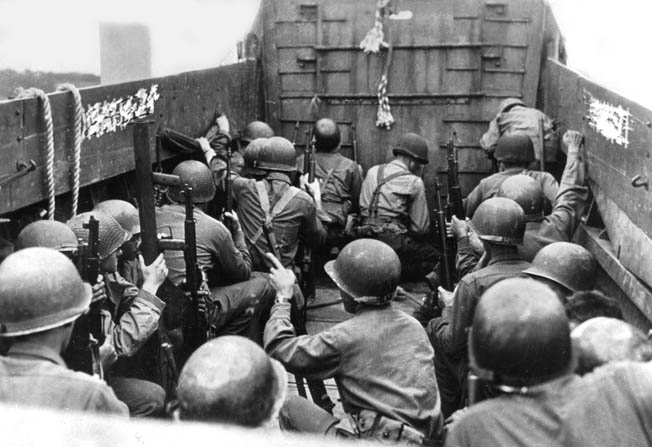
That is just what it was, and it was not a siege. By mid-August the Americans had secured few ports, with Cherbourg and the still useless St. Malo being the largest. With the collapse of the German armies in France and the pursuit across the Seine, the Americans needed more gas, more ammunition, more equipment, and more men. All of these had to come through ports. More were needed. The plan to take Brest stood.
Brest was an old fortress city of some 80,000 people situated along the shore of an excellent, land-locked roadstead some 90 square miles in area. An excellent deep-water harbor, it had been a major French naval base, and, during World War I, had seen many Americans pass through to join the American Expeditionary Forces.
As noted earlier, the railroad ran directly to Rennes, and from there the entire French countryside was easily accessible. Although the Allies had plans to build their own harbor at Quiberon Bay, suppression of Brest was vital to keep the sea lanes open to any of the Brittany ports since it dominated the peninsula.
Middleton now received the use of the 2nd and 29th Infantry Divisions from First Army; both had been fighting since D-Day. In addition, the 2nd and 5th U.S. Ranger Battalions, also D-Day veterans, were added to the troop list, as was the 35th Field Artillery Brigade, Task Force A, and VIII Corps support units. These troops were needed as Middleton had a lot of ground to cover. He had to isolate Lorient and St. Nazaire along with other German enclaves. With the German withdrawal from France sucking all Allied units to the east, Middleton was stretched very thin on the ground.
Near the end of August, an ammunition shortage limited pre-assault bombardments, and Middleton’s request for more ammunition was denied by Third Army, itself short of ammo because it seriously underestimated the Brest garrison’s strength.
As the attack began, VIII Corps had three infantry divisions, two Ranger battalions, an armored task force, and 34 artillery battalions available. The fighting quickly became bitter and bloody. Built on hills on both sides of the Penfeld River, Brest, surrounded by small hills and low ridges with many deep ravines, was in an ideal defensive position.
The usual dense and coordinated German defenses included concrete pillboxes, casemates, and gun emplacements. Barbed wire, minefields, and antitank ditches enhanced the defense. Old French forts and an 18th-century Vauban-designed fortress were integrated into it. Guns and antiaircraft weapons stripped from ships sunk in the harbor joined coast artillery and field artillery facing the Americans.
On August 18, VIII Corps moved to Lesneven 15 miles from Brest to direct the battle; operations to isolate Brest and push in its outposts began almost immediately.
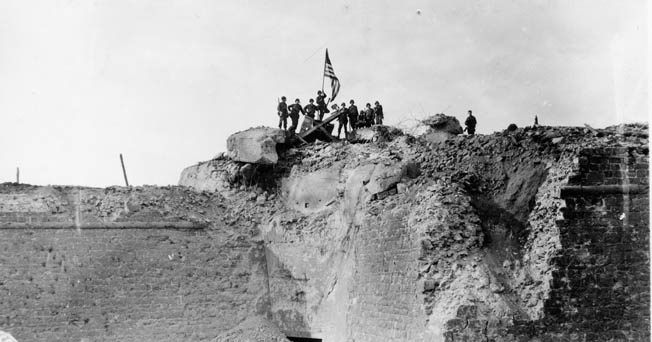
During one of these early operations, the 38th Infantry Regiment, 2nd Infantry Division was fighting near Plougastel, Brittany, on August 23 when it hit stiff resistance. A 28-year-old machine-gun squad leader, Staff Sergeant Alvin P. Carey, was with the company attacking Hill 154. When the advance stalled under heavy enemy fire, Carey moved his guns forward of the leading infantry squads. Leaving his men under cover, Carey loaded himself with as many grenades as he could carry and then started up the hill toward the Germans.
He targeted the central pillbox holding up his buddies and moved 150 yards under direct enemy fire until confronted by a German rifleman. This individual he dispatched with his carbine and moved to within throwing distance of the pillbox and began hurling grenades at it in the face of intense enemy fire, which soon mortally wounded him.
Despite his wounds, he continued to toss grenades until one entered the pillbox and exploded, killing the occupants and putting their guns out of action. For his self-sacrifice, Staff Sergeant Alvin P. Carey received a posthumous Medal of Honor. More than 100 enemy dead were counted on the hill.
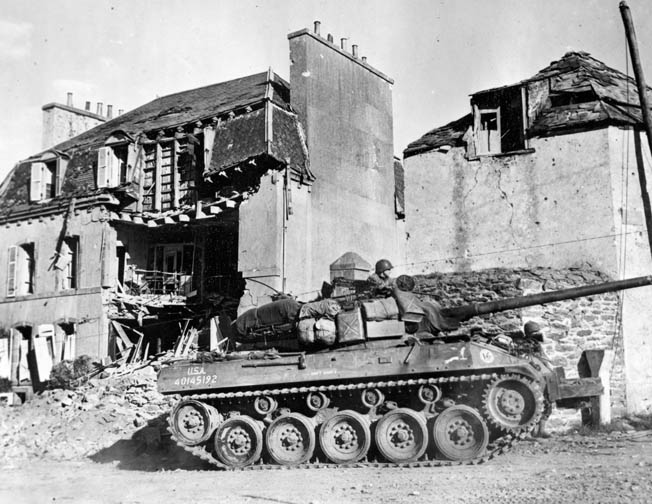
General Middleton organized several task forces to clear the outlying areas around Brest. One such combat element was Task Force B under Colonel Leroy H. Watson, assistant division commander of the 29th Infantry Division. Consisting of the 116th Infantry Regiment, 2nd Ranger Battalion, 224th Field Artillery Battalion, and 86th Cavalry Reconnaissance Squadron, Task Force B captured Pointe de Corsen and isolated German artillery batteries. A small patrol led by 1st Lt. Robert Edlin managed to penetrate the defenses, enter the command post and, by holding an armed grenade to the commander’s head, threatened death or surrender to the enemy troops there. More than 1,000 Germans gave up.
The main attack against Brest began on August 25. Three infantry divisions abreast launched a major assault. The defenses were formed by two belts of some four to six miles around the Penfeld River. Heavy and medium bombers attacked, and fighters launched rockets in the pre-assault barrage. Because of the heavy and deep defenses, progress was slow and costly. When Company G, 23rd Infantry, 2nd Infantry Division dug in on August 29, it was hit with a German counterattack.
Unprepared, Company G was pinned under small arms and antiaircraft fire; the opening left a dangerous gap in the American line. As the Germans approached, Sergeant John J. McVeigh, a machine gunner from Company H, set up his guns to cover the gap, standing fully erect to direct their fire despite intense return fire.
Despite casualties, the Germans kept coming, threatening to overrun Company G. Drawing his trench knife, McVeigh attacked the Germans as they approached his guns and engaged in a savage hand-to-hand struggle, killing one enemy soldier and then, armed only with his knife, charging three others.
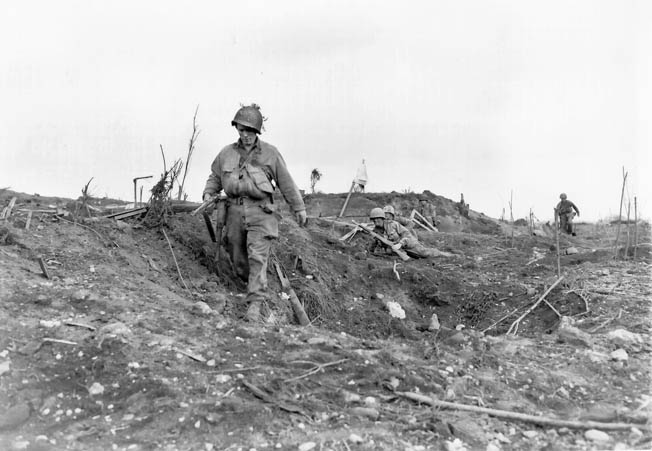
As he did so, he was cut down by enemy rifle fire at point-blank range. But his action allowed the men of Companies H and G to prepare for the continuing enemy attack, which they successfully repelled. For his gallantry and self-sacrifice, McVeigh received a posthumous Medal of Honor.
The bitter fighting continued throughout August. Second Lt. Earl O. Hall of the 13th Infantry, 8th Infantry Division earned a posthumous Distinguished Service Cross for leading a vicious fight among the enemy trenches until killed by artillery fire. In the 2nd Division’s 9th Infantry, Lt. Col. H.K. Wesson reorganized a rifle company, reduced to 46 men, and at the cost of his life led them in an assault across a defended hedgerow, knocking out an enemy machine gun and capturing 14 German paratroopers. He, too, received a posthumous Distinguished Service Cross.
Middleton tried everything to expedite the operation and reduce casualties. His request for an amphibious landing was denied. Additional air strikes were called against the defenses. Replacements for casualties were slow in arriving; ammunition supplies remained low, and air support “left much to be desired.” But the battle went on.
Each division faced one or more of the heavily defended hills that blocked access to the city. The 8th Division faced Hill 92. On September 7, Middleton, his ammunition stocks finally restored, ordered another general assault. The 13th Infantry Regiment sent two battalions against Hill 92. They were halted by intense German fire.
Private First Class Ernest W. Prussman led his squad against the enemy mortars, machine guns, and snipers from concealed positions. Capturing two German soldiers in a trench, he next led his men across an open field swept by enemy fire, destroyed an enemy machine gun, and captured the crew and supporting riflemen. Moving again ahead of his men, he attacked additional enemy positions until he was mortally wounded. For his courageous selflessness, Prussman received a posthumous Medal of Honor.
Not far away, Staff Sgt. George T. Scanlon of the 121st Infantry earned a Distinguished Service Cross for knocking out enemy dugouts holding up that regiment’s advance. It was, as General Robertson later said, “a corporal’s war.”
By September 10, the 8th Infantry Division had reached the inner defense line. The 2nd Infantry Division soon followed, while the 29th Infantry Division struggled with strong defenses in its sector. The converging of the attacking divisions pinched out the 8th Infantry Division, which was then sent to clear the nearby Crozon Peninsula of German artillery supporting Brest. Meanwhile, Middleton again sent a surrender ultimatum to General Ramcke. He declined. Middleton ordered an all-out attack.
The 2nd and 29th Infantry Divisions did just that. Using everything available to them they struck the enemy strongpoints in their zones. For Gerhardt’s 29th, that was Fort Keranroux. The 175th Infantry attacked, led by the 2nd Battalion and Staff Sergeant Sherwood H. Hallman of Company F. When his battalion was halted by a strongly defended enemy position that withstood repeated attacks, Hallman ordered his squad to cover his movements while he advanced alone. He leaped over a hedgerow and into a sunken road, which housed the German defenders.
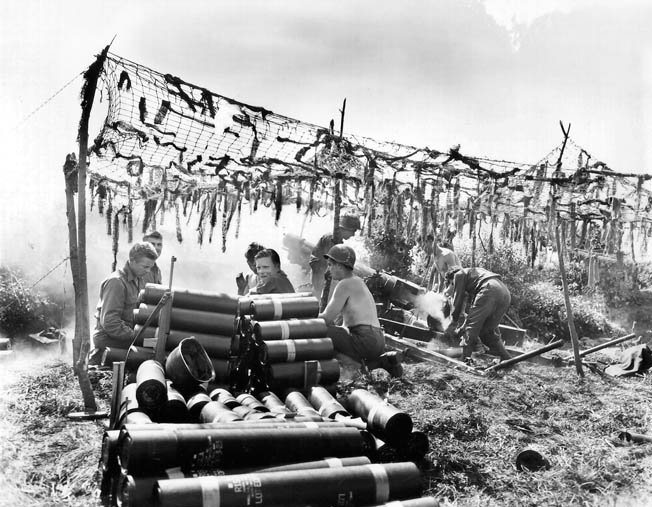
Firing his carbine and hurling grenades, Hallman faced some 30 Germans and at least one machine gun. He killed four of the enemy and then demanded that the rest surrender. Twelve did so, and Hallman turned these over to his squad. Seeing their comrades surrender, another 75 German troops then gave themselves up; these men had been manning the main defensive position that had delayed the 175th Infantry Regiment.
With the surrender, the battalion was able to advance another 2,000 yards before meeting other resistance; Fort Keranroux was captured later that same day. For his gallant leadership at great personal risk, Hallmann received the Medal of Honor.
The battle continued. British flamethrowing tanks of the 141st Regiment, Royal Armoured Corps were brought up to burn out the more stubborn defenders. Engineers cleared minefields and made paths for tanks to support the infantry. The bloody, bitter fighting continued, each day bringing the Americans closer to capturing the city. Street fighting ensued, and as it did small German garrisons, cut off from the main force, began to surrender.
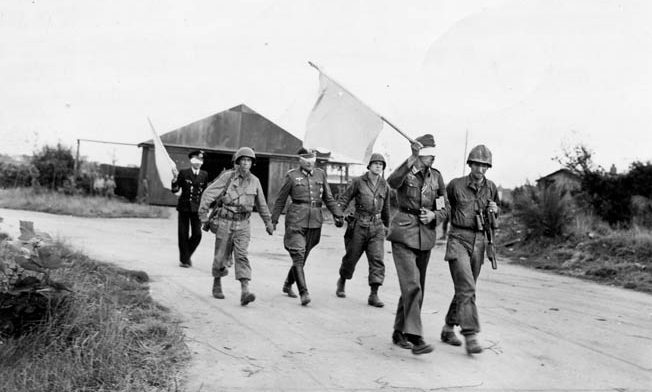
Over on the Crozon Peninsula, General Stroh’s 8th Infantry Division cleared the Germans until only a small group of diehards remained. Supported by the 2nd Ranger Battalion and Task Force A, they attacked the last German position. As they did, General Ramcke sent a message asking to see the credentials of the commanding officer, Brig. Gen. Charles D.W. Canham, the 8th’s assistant division commander.
Fed up with Ramcke’s stubborn, pointless defense and the cost to his troops, Canham pointed to his exhausted, dirty, unshaven men and said, “These are my credentials.” General Ramcke surrendered on September 17.
That ended major combat in Brittany, but not American involvement there. Until the end of the war, American units—first the 94th Infantry Division (Maj. Gen. Harry Maloney) and later the 66th Infantry Division (Maj. Gen. Herman F. Kramer)—spent many frustrating months containing the unsecured French ports at Lorient and St. Nazaire.
The Battle for Brest cost the U.S. Army some 9,831 casualties. Prisoners taken numbered 38,000, including 20,000 combat troops. The 2nd Infantry Division alone had expended 1,750,000 rounds of small arms ammunition and 218,000 rounds of heavy caliber ammunition. All three of the American infantry divisions and the two armored divisions would move to the front lines in eastern France and fight on throughout the war. VIII Corps would be hard hit during the German Ardennes counteroffensive in December.
At the time of its capture, Brest was a totally devastated city. The docks were destroyed. The bridges were destroyed. Most houses were damaged if not destroyed.
After studying the situation and comparing the rapid advances toward Germany, Allied planners decided that Brest was not necessary for Allied logistics. SHAEF decided to abandon plans to develop Lorient, Quiberon Bay, St. Nazaire, and Nantes—a recommendation submitted even before Fort Keranroux fell to the 29th Division.
General Eisenhower, however, thought Brest could still be useful for bringing in troops directly from the United States. In effect, taking Brest was an insurance policy against things going wrong in the future. In September 1944, things were still uncertain, and Brest could still have some value.
About the only positive thing the seizure of Brest accomplished was the elimination of a strong group of aggressive, first-rate enemy soldiers on the Allies’ line of communication. At the time, Generals Bradley and Patton felt that Brest was useless, but “when the American Army had once put its hand to the plow, it should not let go,” according to Bradley then. Perhaps his 1983 opinion of the matter is more to the point.
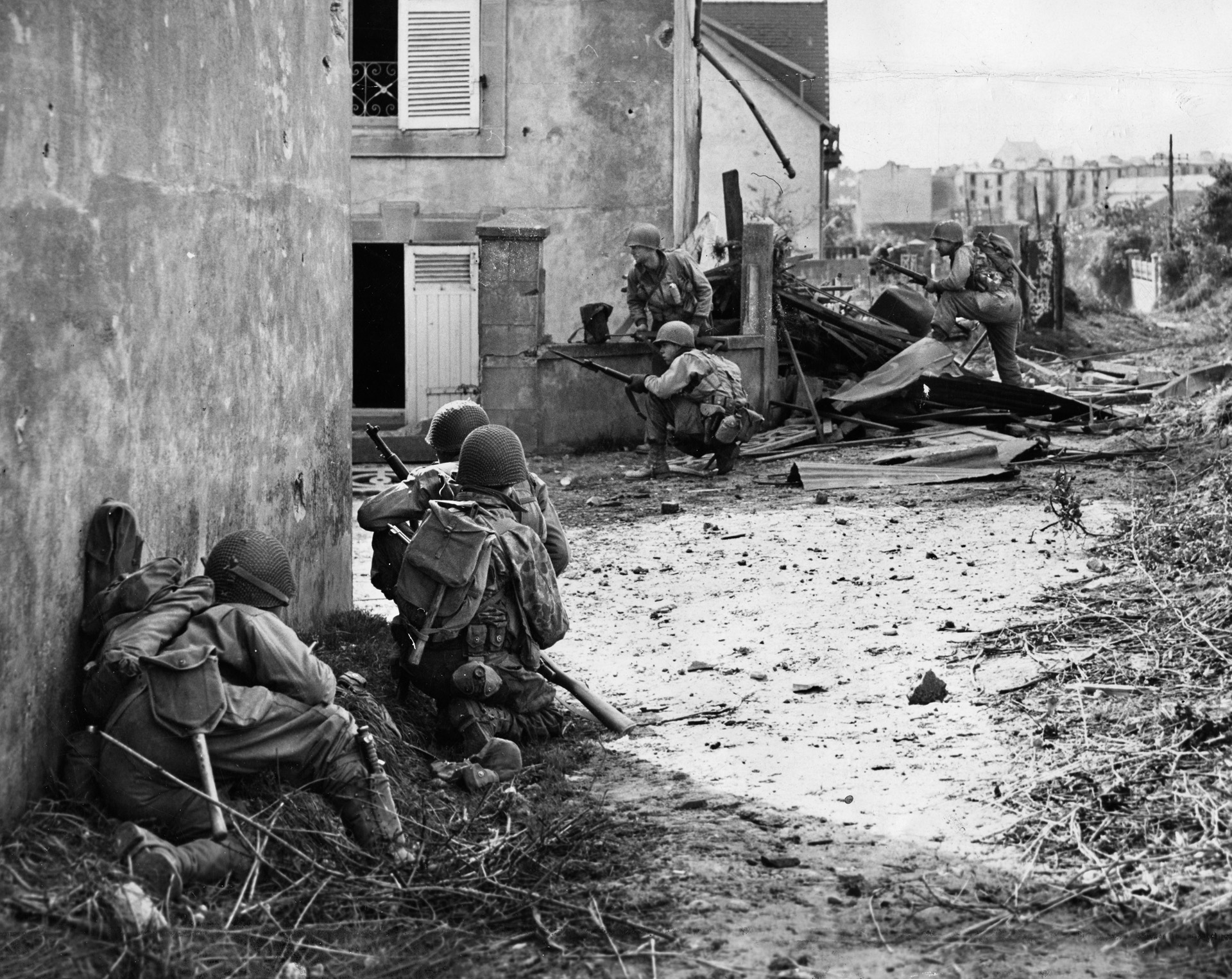
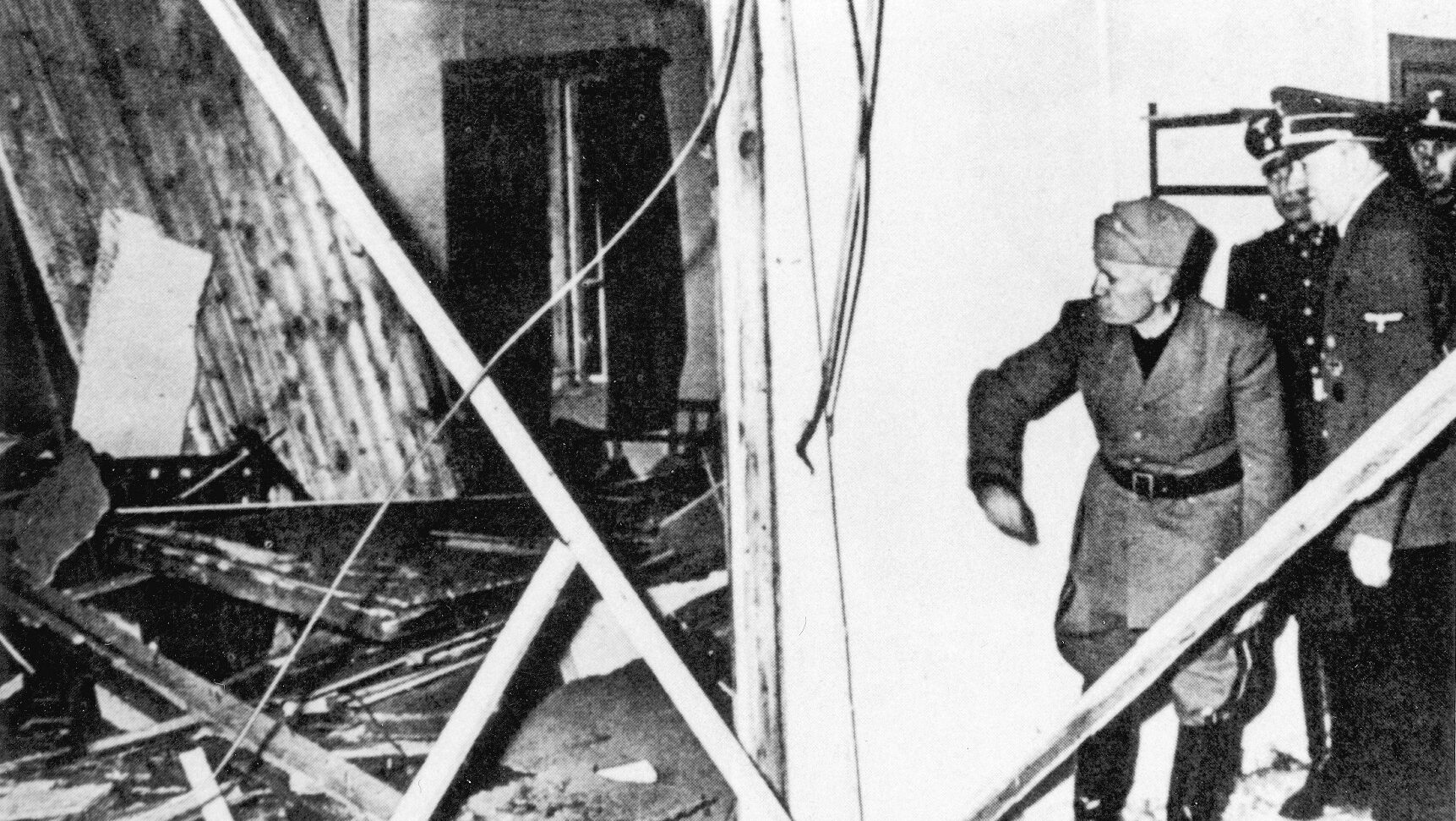
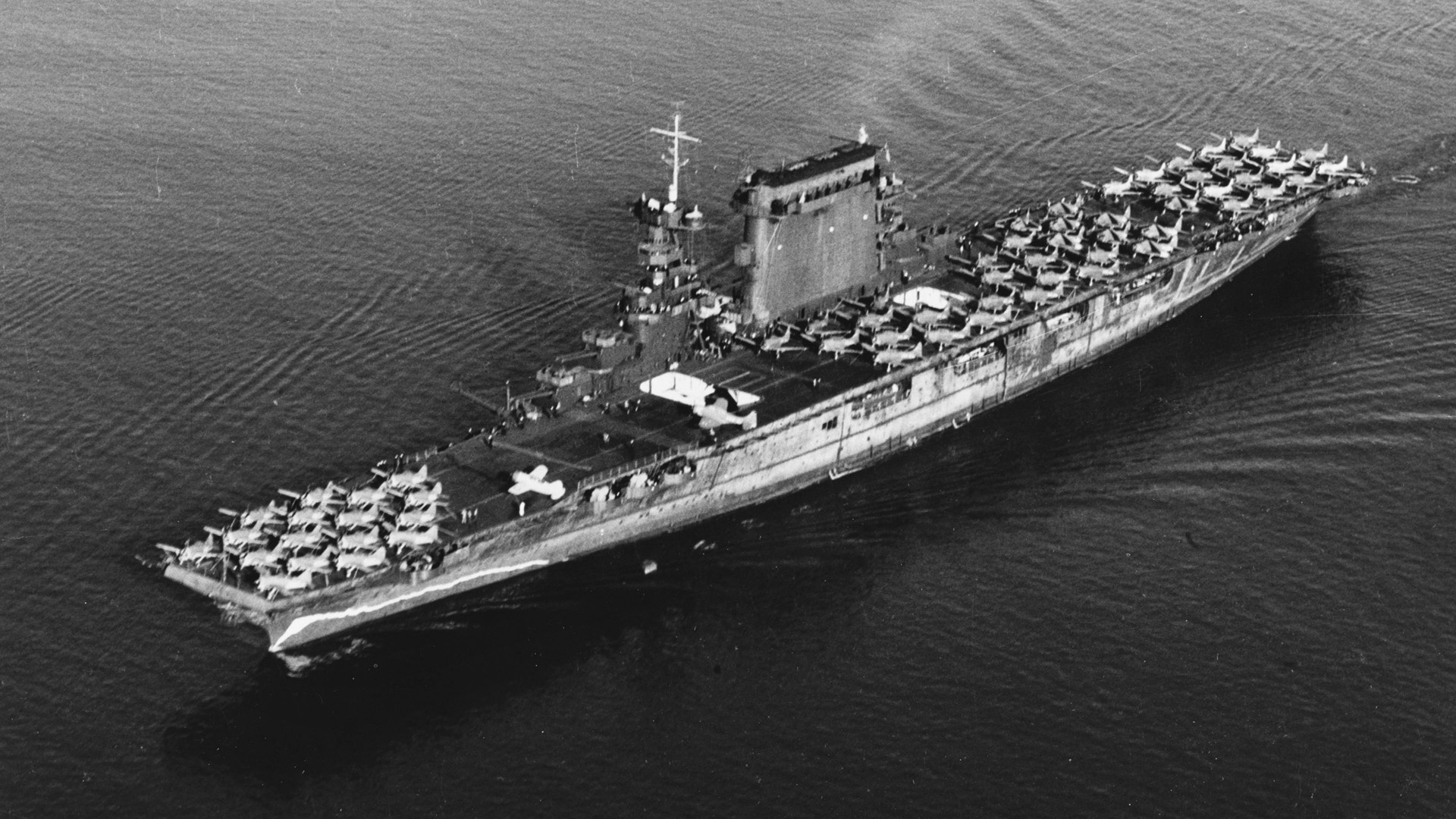
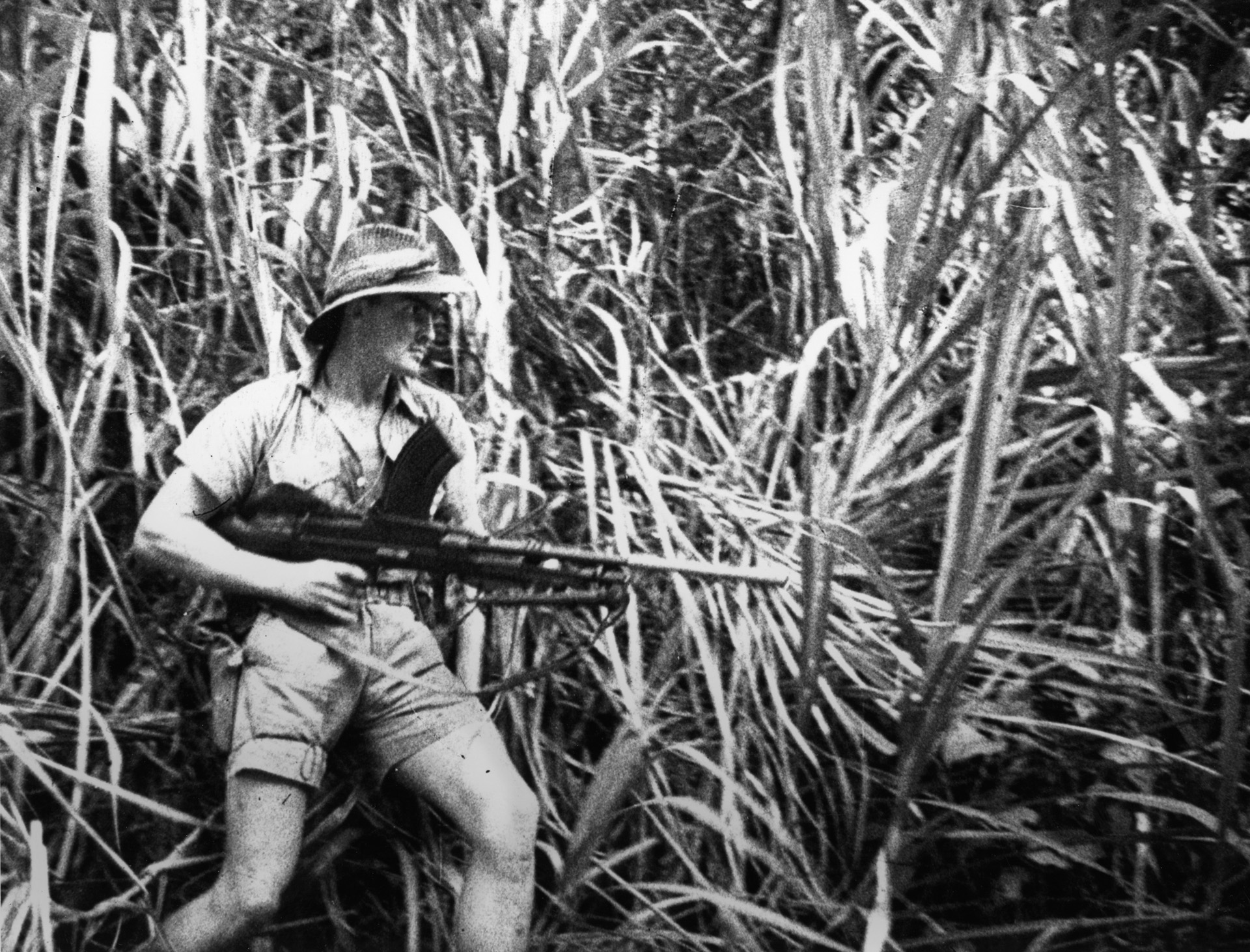
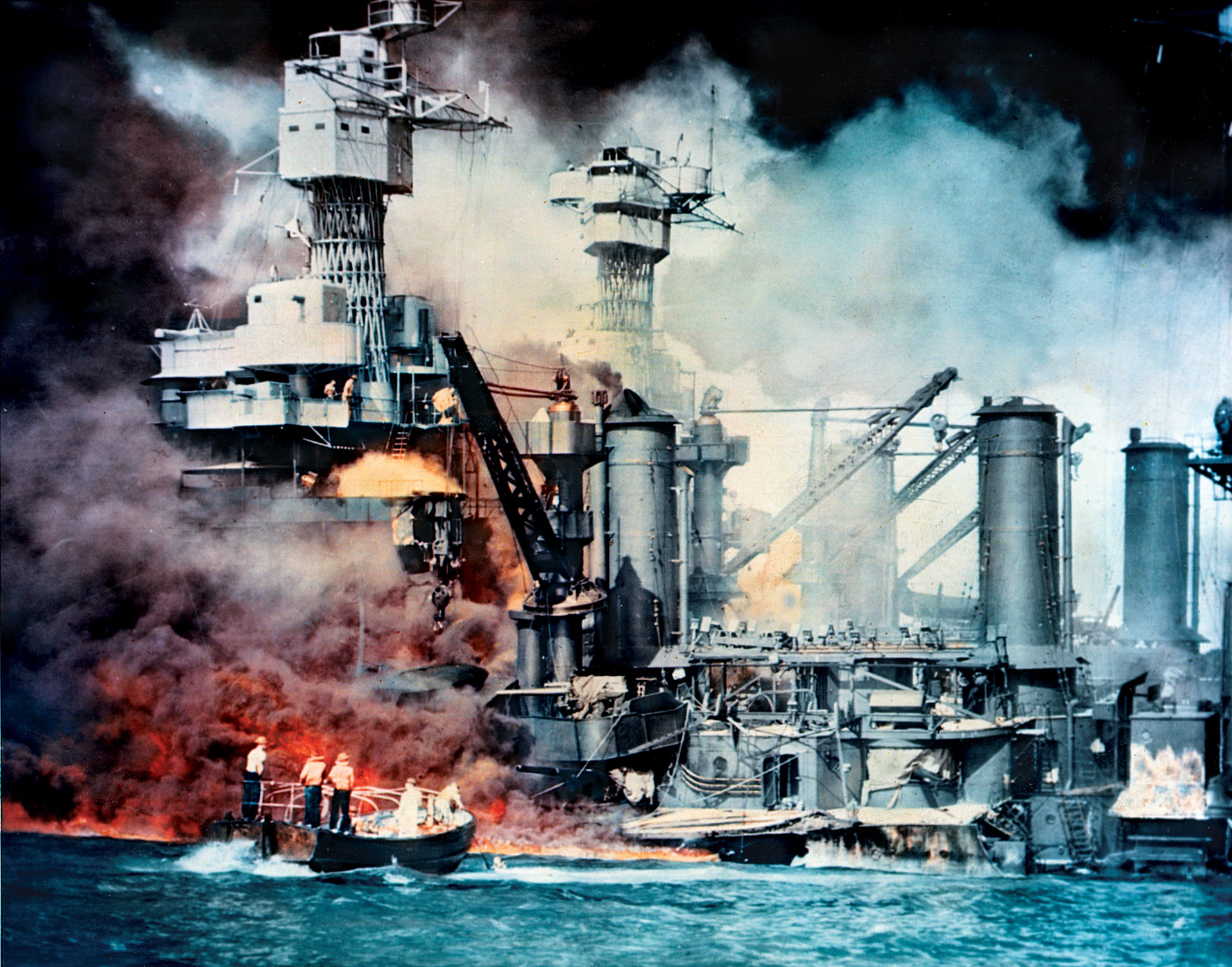
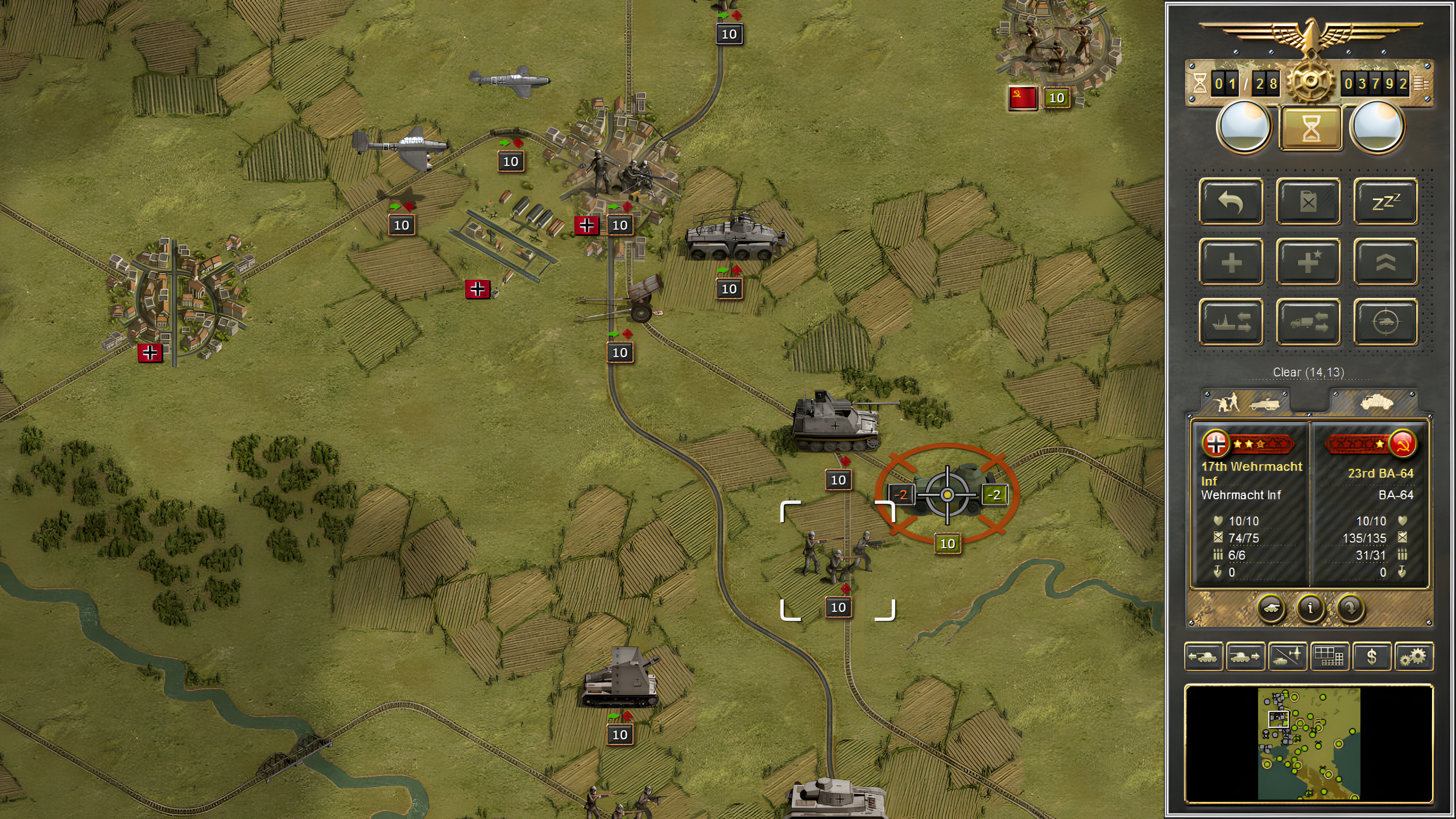
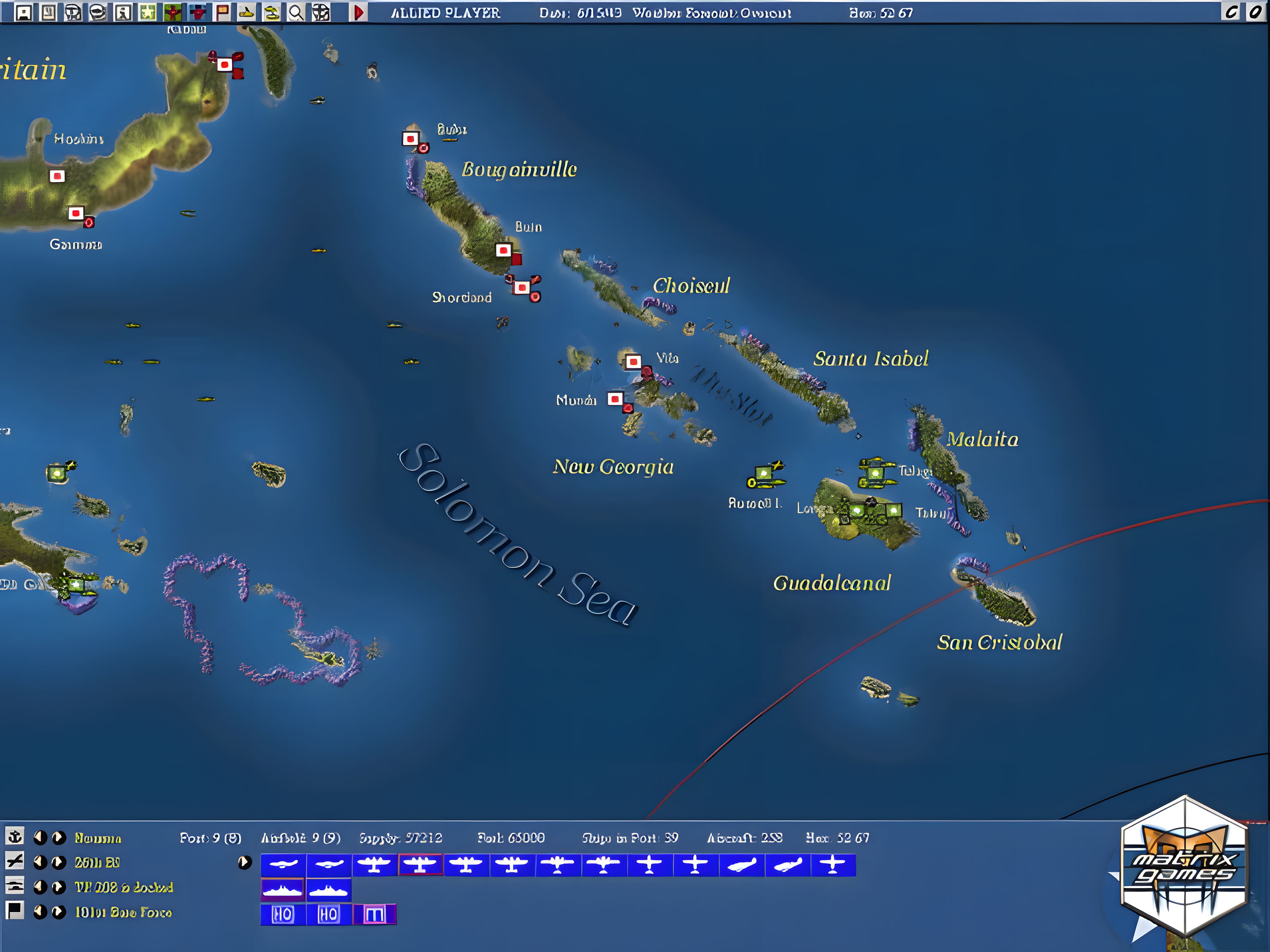
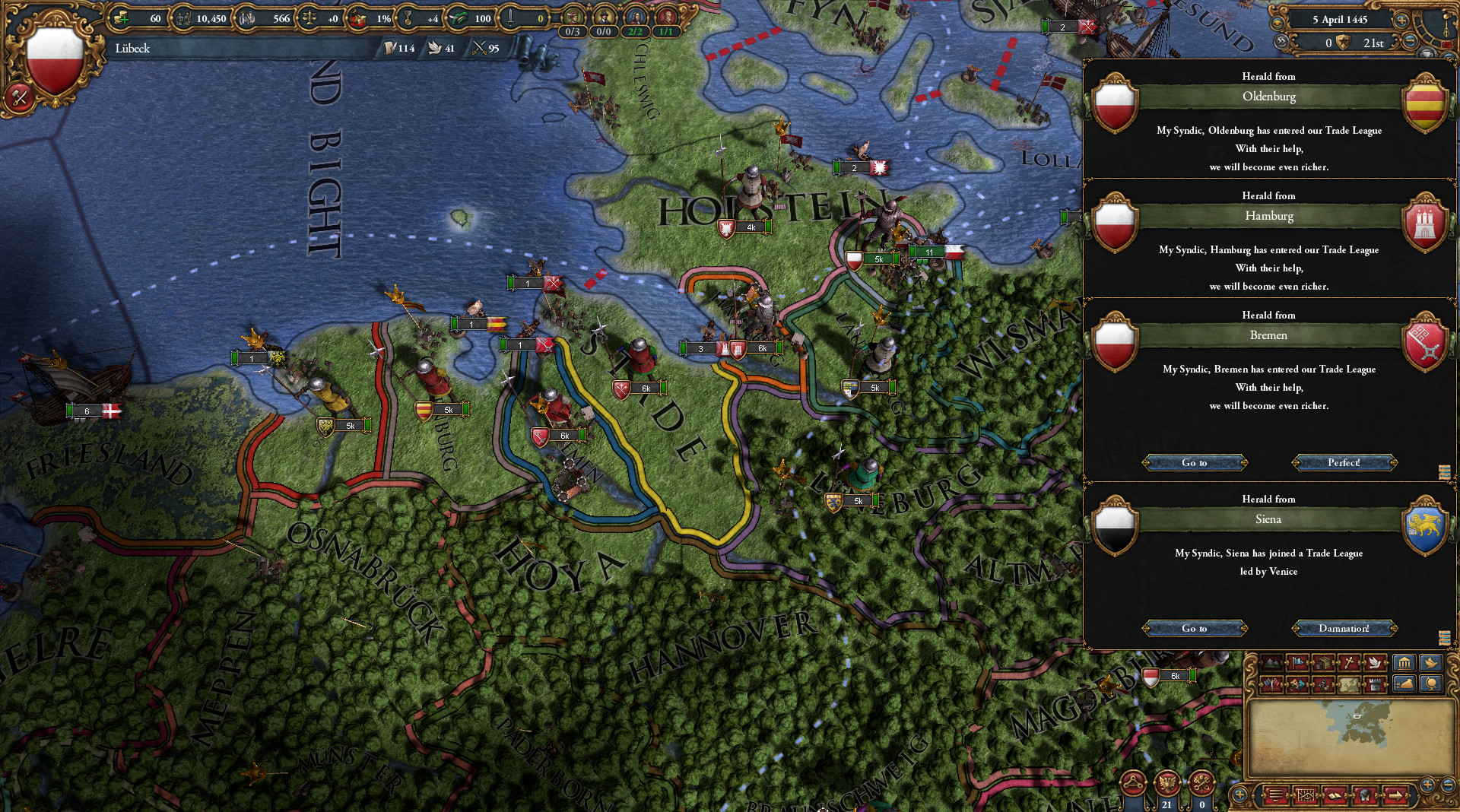
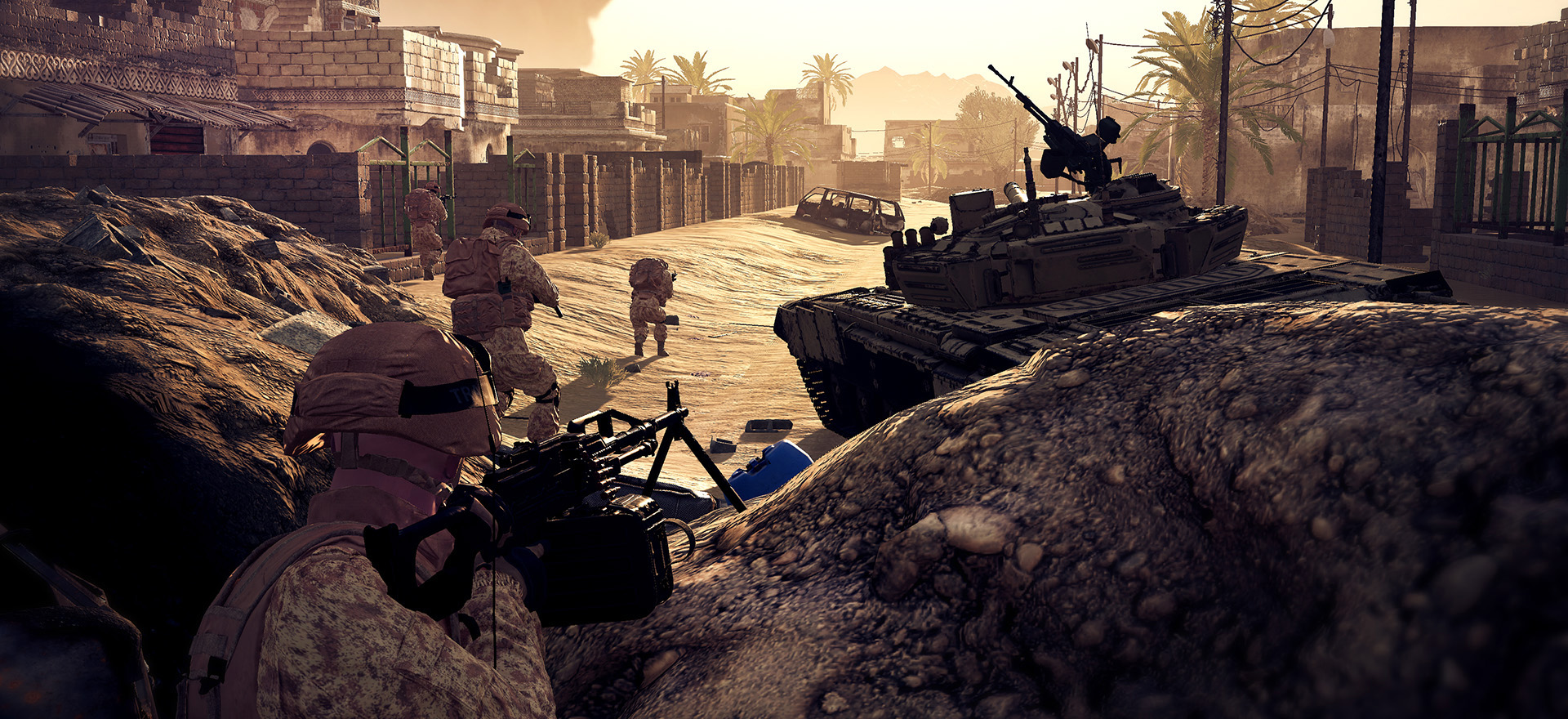
German General Ramcke I hope was tagged a war criminal for
prolonging and causing deaths of his and Allied men for his actions .
Hopefully Hung.
As for Allies , Folly of not copying Nimitz Island hoping as to
German defenses .
Paragraph seven is somewhat misleading – neither Le Havre, Cherbourg, nor Rouen are in Brittany. Rather, they are all in Normandy.